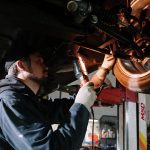Having an unforeseen issue with your sewer line can be both costly and worrisome for homeowners. No one wants to experience a repulsive odor coupled with mold and slow draining on their premises. However, when the home’s plumbing system malfunctions, the issues that erupt are pretty disgusting.
If you suspect that the sewer requires a repair, you may wonder whether homeowner’s insurance covers any related plumbing costs.
Table of Contents
Does Your Homeowner’s Insurance Cover the Sewer Line?
A homeowners insurance covers losses to a house which could include interior damage, exterior damage, and injury that arises while someone is present on the property,
The average homeowner’s insurance premium was about 1,192 dollars in 2016. However, just because the premiums are skyrocketing, that doesn’t mean the insurance will cover you for all types of damage. Insurance companies do not cater to loss caused due to wear and tear of plumbing systems. Therefore, insurance will typically not provide coverage for sewer line damage.
Insurers only honor insurance claims if the damage to the sewer was caused by another party, or it was an ‘act of God.’ However, since physical harm to the plumbing is considered preventable because it is inevitable, insurers will not honor claims. It makes absolutely no difference whether the sewer requires partial or complete repair.
Some insurance companies offer specific coverage options that can be added to a home insurance policy for a nominal cost. The Insurance Information Institute recommends homeowners and businesses to subscribe to supplemental plans so that they can tackle the threat of sewer backups. These supplemental plans can help individuals take advantage of their insurance when they need it the most.
For the best guidance, you should contact a representative from your insurance company and redirect your queries to them.
How Much Will A Sewer Line Repair Cost You?
Cast iron is more brittle compared to other alternatives like ductile iron, which is commonly available in the market. Therefore, after aging, this brittle material tends to crack.
Most homes that were built in the 1980s incorporated ‘cast-iron’ sewer lines. About three to four decades have passed since this material was used for sewer installations, so problems with wear and tear have become common. Tree root intrusions, misaligned joints, and poorly installed sewer lines are a reality that you may need to face.
Once a sewer line issue escalates, you may come across a foul sewer odor, mold, water leaks, and slow draining. The entire fiasco can be described as a homeowner’s worst nightmare.
Usually, homeowners spend anywhere between $1,300 and $2,700 for sewer line repair. While the average cost that they incur is around $2,306, but if someone is especially unlucky, they may even end up paying up to about $6,500 for a sewer line repair.
Traditionally sewers were replaced after digging a trench to make the sewer line more accessible. However, more modern methods like trenchless sewer line repair are safer compared to more conventional means.
When Should A Homeowner File A Claim?
If you suspect sewer line damage was caused due to a third party or you, have purchased specific coverage for sewer backup, file a claim. 19.5 percent of home insurance losses were caused by property damage as a result of water damage and freezing in 2017.
Losses caused by natural disasters like earthquakes and tornadoes are typically not covered by home insurance. However, if you are facing sewer damage due to such occurrences and you have bought specific coverage to protect you financially, you can file a claim.
Don’t waste your time filing a claim if the damage was preventable. So if the pipes are in bad condition as a result of poor upkeep, you should stop expecting any compensation.
Protect Yourself from Sewer Line Damage
Homeowners must realize that they are responsible for the maintenance and repair of the main-line connection to the sewer lateral.
It’s better to invest some money in troubleshooting while you can before you are forced to file an insurance claim. Evading the plumbing problem when it is in its early stages makes no sense. So if you suspect an issue with the sewer, don’t wait for it to escalate. After all, you don’t want to be the one paying thousands of dollars to fix the situation.
Instead of having a reactive approach to your plumbing system, you should always maintain a more proactive approach.
One of the best ways of ascertaining the state of your cast iron sewer line is through a camera inspection. According to HomeAdvisor, a standard sewer camera inspection can cost anywhere between $227 and $800. This procedure will provide you with a visual check of the situation, and you will receive a detailed report.
Whatever you do, don’t be careless when it comes to your sewer. Pay attention to the telltale signs and identify issues before they blow out of proportion. Your strategy should include correcting illegal plumbing connections, periodically cutting tree roots, and replacing the old cast-iron sewer with another material before you are forced to do so.
Final Thoughts
Aging plumbing systems are problematic, and no homeowner wants to pay the substantial costs associated with sewer line repair.
You might be concerned about whether you can recover any costs through your insurance company. However, issues with cast-iron sewer lines are considered preventable. Therefore, you may not be eligible for an insurance claim.
Damage to your property caused by a third party or by an ‘act of God’ can be claimed. It is recommended to purchase supplemental policies that support you with sewer backup costs. But once the damage near completion, there is little you can do except paying the hefty bill.







